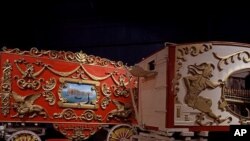“Ladies and gentlemen, and children of all ages!”
That’s a favorite ringmaster’s refrain at the circus, a cherished entertainment tradition across America. And it’s lovingly preserved at two unusual U.S. museums.
It was not a ringmaster’s whistle that heralded “Circus Day” in every decent-sized town in America for several decades on each side of the turn of the 20th Century.
It was the synchronized clopping of draft horses, mingled with the rousing tunes of a brass band atop a four-ton wagon at the head of a grand street parade bearing the circus from the railroad depot into town.
Behind the bandwagon rolled brightly painted chariots; mounted cages carrying big cats, elephants, and other exotic animals; and baggage wagons disguised as theme floats. Raucously bringing up the rear was a steam calliope, piercing the air with peppy, whistled tunes.
Train-borne circuses dwindled to a handful by 1940, and one by one, the gaudy circus wagons found their way into carnivals or storage sheds. Hundreds rotted and rusted in open fields.
But in 1959, John Kelley, a former attorney for the Ringling Brothers Circus, opened Circus World, a museum in Baraboo, Wisconsin, where the five Ringlings had founded their show.
That museum is still going strong. It’s filled with circus wagons that arrived terribly decayed and were then restored. And one weekend each July, they again take a train ride to Milwaukee, 145 kilometers away, where they rumble once again in a Great Circus Parade.
The second circus museum also has a Ringling connection. One of the Ringling brothers - John - and his wife, Mable, built a beautiful estate in Sarasota, Florida. It is now a lavish art museum, owned by the state of Florida. On the grounds, the state built a circus museum containing more circus wagons, an animated miniature circus, spangled costumes and other memorabilia.
These collections are not the Greatest Show on Earth, as the Ringling Brothers called their circus.
But they are a glittering tribute to it.
That’s a favorite ringmaster’s refrain at the circus, a cherished entertainment tradition across America. And it’s lovingly preserved at two unusual U.S. museums.
It was not a ringmaster’s whistle that heralded “Circus Day” in every decent-sized town in America for several decades on each side of the turn of the 20th Century.
It was the synchronized clopping of draft horses, mingled with the rousing tunes of a brass band atop a four-ton wagon at the head of a grand street parade bearing the circus from the railroad depot into town.
Behind the bandwagon rolled brightly painted chariots; mounted cages carrying big cats, elephants, and other exotic animals; and baggage wagons disguised as theme floats. Raucously bringing up the rear was a steam calliope, piercing the air with peppy, whistled tunes.
Train-borne circuses dwindled to a handful by 1940, and one by one, the gaudy circus wagons found their way into carnivals or storage sheds. Hundreds rotted and rusted in open fields.
But in 1959, John Kelley, a former attorney for the Ringling Brothers Circus, opened Circus World, a museum in Baraboo, Wisconsin, where the five Ringlings had founded their show.
That museum is still going strong. It’s filled with circus wagons that arrived terribly decayed and were then restored. And one weekend each July, they again take a train ride to Milwaukee, 145 kilometers away, where they rumble once again in a Great Circus Parade.
The second circus museum also has a Ringling connection. One of the Ringling brothers - John - and his wife, Mable, built a beautiful estate in Sarasota, Florida. It is now a lavish art museum, owned by the state of Florida. On the grounds, the state built a circus museum containing more circus wagons, an animated miniature circus, spangled costumes and other memorabilia.
These collections are not the Greatest Show on Earth, as the Ringling Brothers called their circus.
But they are a glittering tribute to it.






